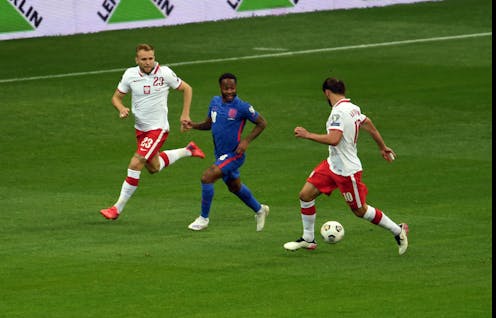
Every team still competing in the Fifa World Cup is determined to get their hands on football’s ultimate prize. But willpower isn’t everything. Success on the pitch also depends on the players’ abilities to run for long distances, including high-intensity bursts and occasional short sprints.
Our new research shows that footballers can be categorised into two distinct running styles that we’ve dubbed “grizzlies” and “gazelles”. These findings have clear implications for developing unique training programmes that optimise the performance of either type of player.
Football requires running at variable speeds – a key aspect of performance that demands monitoring and analysis in both games and training. Apart from walking, elite football players’ speeds range from 7.2 to 14.3 km/h for jogging, 14.4 to 19.7 km/h for running, 19.8 to 25.1 km/h for high-speed running, and exceed 25.1 km/h for sprinting.
A crucial factor in running mechanics is leg stiffness. This isn’t the same as the pain and soreness you feel in your muscles after a long run or repeated sprints at high intensities. In a sporting performance context, leg stiffness is related to muscle tension – helping to store and reuse energy. A player with high muscle stiffness has a lot of muscle tension, meaning they waste less energy as they run up and down the pitch.
Our research has identified two distinct running styles based on leg stiffness: “aerial” and “terrestrial”. Aerial runners have high leg stiffness characterised by a spring-like vertical bouncing manner, which is a seemingly more economical running style. This is similar to how gazelles run.
By contrast, terrestrial runners have low leg stiffness identified by a more grounded, horizontal gait. They are potentially more suited to short sprints and fast changes in direction. This is similar to how grizzly bears run.
(These metaphors are based on the visual imagery of how these animals run, rather than their body size or shape.)
The importance of running style
In our research, we asked 25 English Premier League football players to run on a treadmill while we analysed their running styles. We found that using a measure known as the “duty factor” is a simple but effective way to describe running styles. This is calculated as the ratio of the time the foot is in contact with the ground and the time between two successive placements of that foot.
Lower duty factors are associated with shorter time touching the ground, longer time in the air and higher leg stiffness – gazelle style. Conversely, higher duty factors are associated with longer time on the ground, shorter time in the air and lower leg stiffness – like grizzlies.
In fact, we discovered that most players have a gazelle or grizzly running style across different speeds. In particular, “wide players” such as wingers and fullbacks typically displayed a gazelle running style, whereas central midfielders typically adopted a more grizzly-like running style.
Interestingly, some players could not be consistently categorised in either group. For one player, the duty factor decreased by 26% between the speeds of 12 and 20 km/h. He reused energy better at faster speeds than other players in the group, but was better at changing direction at lower speeds. This winger was therefore categorised as a “kangaroo”, possessing leg stiffness properties that return more energy the faster it moves.

Our evidence suggests that gazelle runners might be more economical than grizzly runners at faster speeds, and thus more suited to continuous box-to-box running. By contrast, grizzly runners might be better suited to short sprints and marking opponents because their more grounded style allows for easier changes in direction.
Training implications
It is conceivable that gazelle players can optimise their energy resources by adopting the grizzly style when running in short, reactive bursts and the gazelle style when required to run for longer periods.
From a training perspective, it seems sensible for football players to improve aspects of both running styles to manage the demands of different running speeds, and to focus not only on their strengths but also their weaknesses. However, if the coach wishes to improve the running performance of each player, they should also exploit the player’s natural running style.
Research has suggested that high-intensity exercises such as plyometrics (using speed and force of different movements to build muscle power) will enhance leg stiffness and might suit the aerial patterns of gazelles. In contrast, resistance training (such as sled-pulling) might be better suited for the running style of the terrestrial grizzlies.
Ultimately, either type of player will benefit from training methods that improve the capacity of their muscles to create force, which could be specific to different lower-limb joints (such as hips and ankles). However, which exact exercise would benefit them the most could be influenced by their unique running style.
Running style preferences could also have other important implications, such as for recovery needs. This would be particularly useful at events such as the World Cup in Qatar, with its energy-sapping conditions and schedule.
The authors do not work for, consult, own shares in or receive funding from any company or organisation that would benefit from this article, and have disclosed no relevant affiliations beyond their academic appointment.
This article was originally published on The Conversation. Read the original article.







